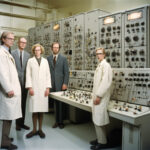US Lab Opens Door for Plasma Jets to Skip Lasers for Nuclear Fusion Breakthrough
In the realm of nuclear fusion research, a groundbreaking development is underway at the Los Alamos National Laboratory (LANL) in the United States. LANL has embarked on a mission to revolutionize the field by exploring an innovative approach that could potentially bypass the conventional use of lasers in nuclear fusion experiments. This bold initiative, known as the Plasma Liner Experiment, has captured the attention of scientists and industry experts alike, signaling a new chapter in the quest for sustainable energy solutions.
The traditional method of achieving nuclear fusion involves using high-powered lasers to compress and heat the fusion fuel, such as hydrogen isotopes, to extreme temperatures and pressures, mimicking the conditions at the core of the sun. While this approach has shown promise, it comes with significant technical challenges and hefty operational costs. LANL’s Plasma Liner Experiment seeks to disrupt this paradigm by harnessing the power of plasma jets to achieve fusion reactions in a more efficient and cost-effective manner.
At the heart of this groundbreaking experiment is the concept of using plasma jets to create a rapidly moving liner that can compress the fusion fuel, triggering the fusion process. By eliminating the need for massive laser systems and complex optics, LANL aims to streamline the fusion process and make it more accessible for future energy applications. This novel approach holds the potential to not only accelerate fusion research but also pave the way for practical fusion energy systems that could one day power our world sustainably.
LANL’s pursuit of commercial partners for the Plasma Liner Experiment underscores the lab’s commitment to advancing research and development in the field of nuclear fusion. By forging collaborations with industry stakeholders, LANL aims to leverage external expertise and resources to drive innovation and expedite the transition of fusion technology from the lab to the marketplace. This strategic partnership approach reflects a growing trend in the scientific community, where public and private sectors join forces to tackle complex challenges and unlock new opportunities for technological advancement.
The implications of LANL’s pioneering work extend beyond the realm of nuclear fusion, offering valuable insights and inspiration for the broader scientific community. By pushing the boundaries of conventional thinking and exploring unconventional pathways to fusion energy, LANL sets a precedent for creative problem-solving and interdisciplinary collaboration. The Plasma Liner Experiment serves as a testament to the power of human ingenuity and persistence in the face of formidable scientific hurdles.
As the global demand for clean and sustainable energy sources continues to rise, the need for transformative solutions like nuclear fusion becomes increasingly urgent. LANL’s innovative approach to fusion research not only holds the promise of abundant and carbon-free energy but also exemplifies the spirit of exploration and discovery that drives scientific progress. By challenging established norms and embracing unconventional ideas, LANL opens the door to a future where plasma jets may indeed pave the way for a nuclear fusion breakthrough of unprecedented scale.
In conclusion, the Plasma Liner Experiment at LANL represents a shining example of scientific innovation and collaboration in the pursuit of sustainable energy solutions. By daring to think differently and push the boundaries of possibility, LANL inspires us to envision a world where nuclear fusion is not just a distant dream but a tangible reality. As we witness the evolution of fusion research unfold before our eyes, one thing is clear: the future of energy is bright, and plasma jets may well hold the key to unlocking its full potential.
US Lab, Plasma Jets, Nuclear Fusion, Energy Solutions, Scientific Innovation












